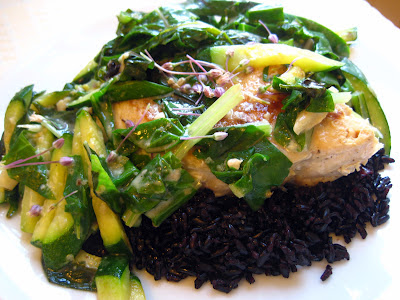Good for when you're low on time and happen to have some tomatoes and fresh cilantro on hand. It reheats well, so consider doubling the recipe and saving some leftovers for lunches. Serve over brown, black, or white rice.
Ingredients
1 onion, chopped
2 cloves garlic, chopped
1 can cannellini beans, drained and rinsed
1 tsp Aleppo pepper (or sub a small pinch of cayenne)
1 1/2 cups chopped ripe, fragrant tomatoes (or halved cherry tomatoes)
Small handful fresh cilantro, chopped
Salt and freshly ground black pepper
1/2 cup grated pepper jack cheese (optional)
Sprinkle the tomatoes with a couple pinches of salt, toss, and let sit while you begin to cook (the salt draws the flavor out of the tomato and makes it taste more tomatoey—a particularly handy trick if you're using supermarket tomatoes or tomatoes that have been in the fridge).
Heat a nonstick pan over medium heat. When hot, add a generous glug of olive oil. Add the onion and saute, stirring occasionally, until it softens and smells sweet. Add the garlic and a pinch of salt and continue to saute, turning the heat down to medium-low and adding a little more olive oil if necessary, until the onion begins to turn golden in a few places.
Add the beans and turn the heat back up to medium. Saute, stirring from time to time, for 3-4 minutes more. Sprinkle with Aleppo pepper to taste, and turn off the heat. Cover and let sit 5-15 more minutes to let the flavor blend while the rice finishes cooking.
Toss the tomatoes with the cilantro and a little drizzle of olive oil. Serve in layers: rice (sprinkled with a little cheese if desired), beans, then tomatoes on the top.
Serves 2-3.



































